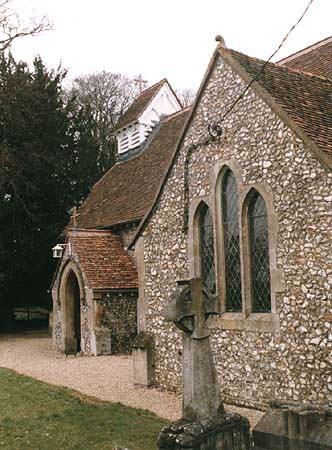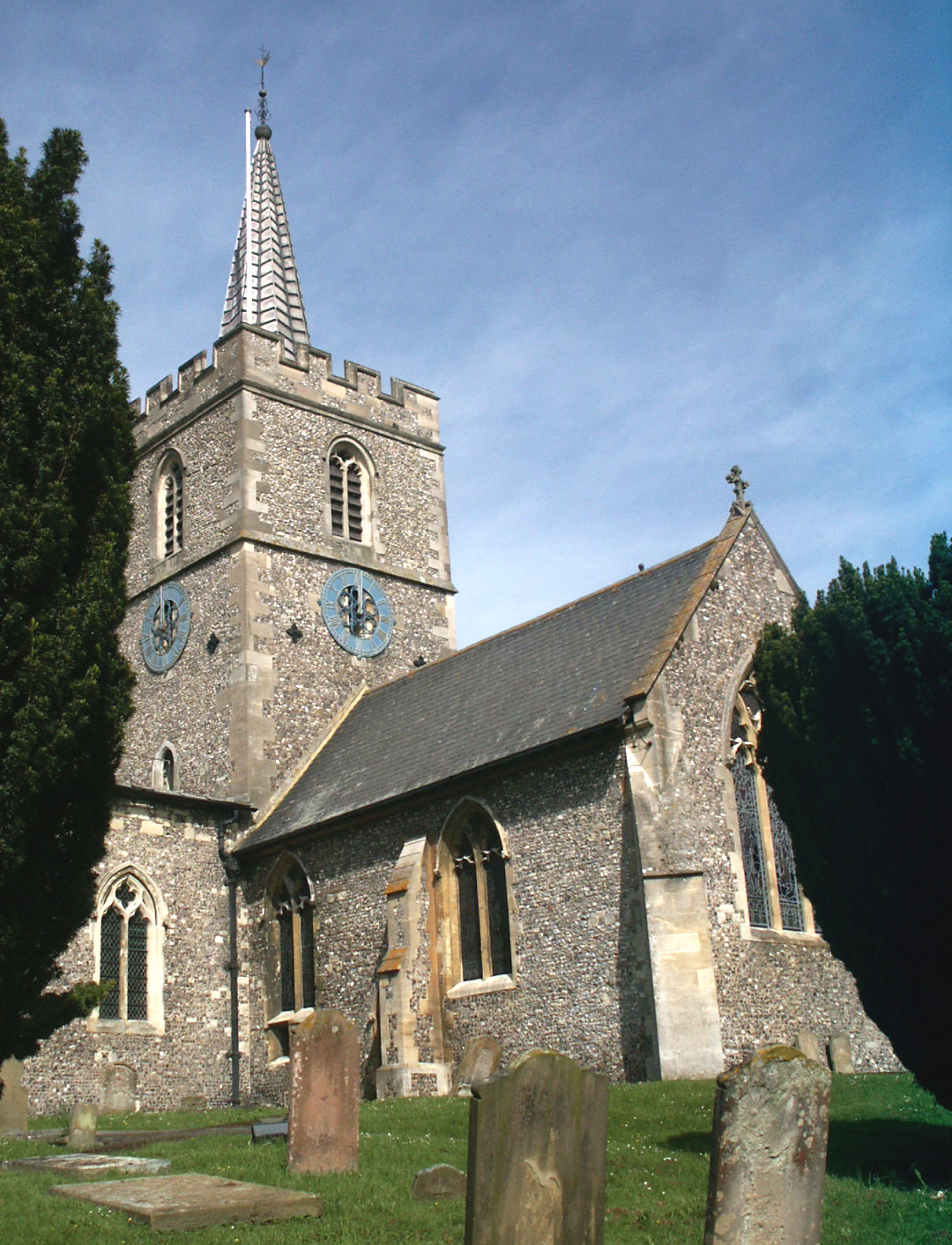|
Hawridge
Hawridge, (recorded as Hoquerug in the 12th century) is a small village in the Chilterns in the county of Buckinghamshire, England and bordering the county boundary with Hertfordshire. It is from Chesham, from both Tring and Berkhamsted. Hawridge is one of four villages comprising Cholesbury-cum-St Leonards, a civil parish within Chiltern District. It is a rural community but the agricultural economy is small and most local people rely for employment on neighbouring towns, the proximity of London, the availability of broadband technology or local tourism and the popularity of the area for recreational activities. Geography Before the incorporation of additional land from adjacent parishes, Hawridge historically comprised some . It is located in the main along a ridge on the dip slope within the Chiltern downland landscape. It is some 590 ft (182 m) above sea level. Geology The geology of the area has dictated the land use. The soil comprises gravely clay, intermixed wit ... [...More Info...] [...Related Items...] OR: [Wikipedia] [Google] [Baidu] |
Cholesbury
Cholesbury (recorded as Chelwardisbyry in the 13th century) is a village in Buckinghamshire, England, on the border with Hertfordshire. It is situated in the Chiltern Hills, about east of Wendover, north of Chesham and from Berkhamsted. Cholesbury is one of four villages comprising Cholesbury-cum-St Leonards, a civil parish within Chiltern District. Braziers End is a hamlet which has always been closely associated with Cholesbury. It is a rural community and most local people rely for employment on neighbouring towns, the proximity of London and the availability of broadband technology. Geography At , Cholesbury is one of the smallest villages in the county and is located within Chiltern downland landscape on the upland plateau and close to the chalk escarpment which overlooks the Aylesbury Vale. At its highest point the village is some above sea level. Geology The geology of the area has dictated the land use. The soil comprises gravely clay, intermixed with flints, sm ... [...More Info...] [...Related Items...] OR: [Wikipedia] [Google] [Baidu] |
Cholesbury-cum-St Leonards
Cholesbury-cum-St Leonards is a civil parish in the Chiltern district of the English county of Buckinghamshire. It lies in the Chiltern Hills just to the north of Chesham, on the boundary with Hertfordshire. It comprises the hamlet of Buckland Common, and the villages of Cholesbury, Hawridge and St Leonards (with Lane Ends hamlet) which were brought together as part of the local government reorganisation in April 1934. The parish has since increased in size through the annexing of additional parcels of land which previously were part of Chesham, Ashley Green and Drayton Beauchamp. History In common with many other villages close to the scarp of the Chiltern Hills, the parishes formed from the ancient manors and estates ran from the fertile Vale of Aylesbury up the step wooded slope onto the Chiltern plateau and dip slope. They are collectively known by the social geographic term of strip parishes. Over time the upland communities, which had originally been temporary outpost ... [...More Info...] [...Related Items...] OR: [Wikipedia] [Google] [Baidu] |
Chesham
Chesham (, , or ) is a market town and civil parish in Buckinghamshire Buckinghamshire (), abbreviated Bucks, is a ceremonial county in South East England that borders Greater London to the south-east, Berkshire to the south, Oxfordshire to the west, Northamptonshire to the north, Bedfordshire to the north-ea ..., England, south-east of the county town of Aylesbury, north-west of Charing Cross, central London, and part of the London metropolitan area, London commuter belt. It is in the River Chess, Chess Valley, surrounded by farmland. The earliest records of Chesham as a settlement are from the second half of the 10th century, although there is archaeological evidence of people in this area from around 8000 BC. Henry III of England, Henry III granted a royal charter for a weekly market in 1257. Chesham is known for its ''four Bs'' boots, beer, brushes and Baptists. In the face of fierce competition from both home and abroad during the later 19th and early 20th cent ... [...More Info...] [...Related Items...] OR: [Wikipedia] [Google] [Baidu] |
St Leonards, Buckinghamshire
St Leonards is a small village in the Chiltern Hills in Buckinghamshire, England. It is 3 miles east of Wendover and 4 miles south of Tring, Hertfordshire. A short section of Grim's Ditch delineates the northern end of the village, which lies within the civil parish of Cholesbury-cum-St Leonards. Early history Prehistoric The earliest evidence of habitation is indicated by a short section of the Chiltern Grim's Ditch linear earthwork, which is believed to have been constructed during the Iron Age. Though what remains is eroded and poorly preserved a ditch and bank are still visible. There are also examples of pottery shards, possibly associated with a small Iron Age bloomery found in a brick-earth quarry and iron slag (at Newsetts Wood) indicating there was a significant community living in the area close to the present-day Dundridge Manor. [...More Info...] [...Related Items...] OR: [Wikipedia] [Google] [Baidu] |
Buckland Common
Buckland Common is a hamlet in Buckinghamshire, England. It is located in the Chiltern Hills, east of Wendover and the same distance south of Tring in Hertfordshire with which it shares a boundary. The northern end of the settlement is delineated by a short section of Grim's Ditch. It is in the civil parish of Cholesbury-cum-St Leonards. Early settlement Prehistoric Evidence of prehistoric settlement has been found in the form of a Palaeolithic handaxe found on a ploughed field'. A section of the Chiltern Grim's Ditch linear earthwork, which is believed to have been constructed during the Iron Age, marks the northern boundary of Buckland Common. Though what remains is eroded and only a poorly preserved ditch and bank are still visible.Unlocking Buckinghamshire's past , Accessed 13 December 2012 ...
|
Chiltern Hills
The Chiltern Hills is a chalk escarpment in England. The area, northwest of London, covers stretching from Goring-on-Thames in the southwest to Hitchin in the northeast - across Oxfordshire, Buckinghamshire, Hertfordshire, and Bedfordshire. The hills are at their widest. In 1965 almost half of the Chiltern Hills was designated as an Area of Outstanding Natural Beauty (AONB). The northwest boundary is clearly defined by the escarpment. The dip slope is by definition more gradual, and merges with the landscape to the southeast. The southwest endpoint is the River Thames. The hills decline slowly in prominence in northeast Bedfordshire.The Changing Landscape of the Chilterns Chilterns AoNB, Accessed 19 February 2012 < ...
|
AONB
An Area of Outstanding Natural Beauty (AONB; , AHNE) is an area of countryside in England, Wales, and Northern Ireland, that has been designated for conservation due to its significant landscape value. Areas are designated in recognition of their national importance by the relevant public body: Natural England, Natural Resources Wales, and the Northern Ireland Environment Agency respectively. In place of AONB, Scotland uses the similar national scenic area (NSA) designation. Areas of Outstanding Natural Beauty enjoy levels of protection from development similar to those of UK national parks, but unlike national parks the responsible bodies do not have their own planning powers. They also differ from national parks in their more limited opportunities for extensive outdoor recreation. History The idea for what would eventually become the AONB designation was first put forward by John Dower in his 1945 ''Report to the Government on National Parks in England and Wales''. Dower ... [...More Info...] [...Related Items...] OR: [Wikipedia] [Google] [Baidu] |
Valentinian I
Valentinian I ( la, Valentinianus; 32117 November 375), sometimes called Valentinian the Great, was Roman emperor from 364 to 375. Upon becoming emperor, he made his brother Valens his co-emperor, giving him rule of the eastern provinces. Valentinian retained the west. During his reign, Valentinian fought successfully against the Alamanni, Quadi, and Sarmatians. Most notable was his victory over the Alamanni in 367 at the Battle of Solicinium. His general Count Theodosius defeated a revolt in Africa and the Great Conspiracy, a coordinated assault on Roman Britain by Picts, Scots, and Saxons. Valentinian was also the last emperor to conduct campaigns across both the Rhine and Danube rivers. Valentinian rebuilt and improved the fortifications along the frontiers, even building fortresses in enemy territory. He founded the Valentinianic dynasty, with his sons Gratian and Valentinian II succeeding him in the western half of the empire. Early life Valentinian was born in 321 ... [...More Info...] [...Related Items...] OR: [Wikipedia] [Google] [Baidu] |
Old English Language
Old English (, ), or Anglo-Saxon, is the earliest recorded form of the English language, spoken in England and southern and eastern Scotland in the early Middle Ages. It was brought to Great Britain by Anglo-Saxon settlers in the mid-5th century, and the first Old English literary works date from the mid-7th century. After the Norman conquest of 1066, English was replaced, for a time, by Anglo-Norman (a relative of French) as the language of the upper classes. This is regarded as marking the end of the Old English era, since during this period the English language was heavily influenced by Anglo-Norman, developing into a phase known now as Middle English in England and Early Scots in Scotland. Old English developed from a set of Anglo-Frisian or Ingvaeonic dialects originally spoken by Germanic tribes traditionally known as the Angles, Saxons and Jutes. As the Germanic settlers became dominant in England, their language replaced the languages of Roman Britain: Common Br ... [...More Info...] [...Related Items...] OR: [Wikipedia] [Google] [Baidu] |
Oxford
Oxford () is a city in England. It is the county town and only city of Oxfordshire. In 2020, its population was estimated at 151,584. It is north-west of London, south-east of Birmingham and north-east of Bristol. The city is home to the University of Oxford, the oldest university in the English-speaking world; it has buildings in every style of English architecture since late Anglo-Saxon. Oxford's industries include motor manufacturing, education, publishing, information technology and science. History The history of Oxford in England dates back to its original settlement in the Saxon period. Originally of strategic significance due to its controlling location on the upper reaches of the River Thames at its junction with the River Cherwell, the town grew in national importance during the early Norman period, and in the late 12th century became home to the fledgling University of Oxford. The city was besieged during The Anarchy in 1142. The university rose to dom ... [...More Info...] [...Related Items...] OR: [Wikipedia] [Google] [Baidu] |
Ashmolean Museum
The Ashmolean Museum of Art and Archaeology () on Beaumont Street, Oxford, England, is Britain's first public museum. Its first building was erected in 1678–1683 to house the cabinet of curiosities that Elias Ashmole gave to the University of Oxford in 1677. It is also the world's second university museum, after the establishment of the Kunstmuseum Basel in 1661 by the University of Basel. The present building was built between 1841 and 1845. The museum reopened in 2009 after a major redevelopment, and in November 2011, new galleries focusing on Egypt and Nubia were unveiled. In May 2016, the museum also opened redisplayed galleries of 19th-century art. History Broad Street The museum opened on 24 May 1683, with naturalist Robert Plot as the first keeper. The building on Broad Street (later known as the Old Ashmolean) is sometimes attributed to Sir Christopher Wren or Thomas Wood. Elias Ashmole had acquired the collection from the gardeners, travellers, and collectors Joh ... [...More Info...] [...Related Items...] OR: [Wikipedia] [Google] [Baidu] |
Bronze Age
The Bronze Age is a historic period, lasting approximately from 3300 BC to 1200 BC, characterized by the use of bronze, the presence of writing in some areas, and other early features of urban civilization. The Bronze Age is the second principal period of the three-age system proposed in 1836 by Christian Jürgensen Thomsen for classifying and studying ancient societies and history. An ancient civilization is deemed to be part of the Bronze Age because it either produced bronze by smelting its own copper and alloying it with tin, arsenic, or other metals, or traded other items for bronze from production areas elsewhere. Bronze is harder and more durable than the other metals available at the time, allowing Bronze Age civilizations to gain a technological advantage. While terrestrial iron is naturally abundant, the higher temperature required for smelting, , in addition to the greater difficulty of working with the metal, placed it out of reach of common use until the end o ... [...More Info...] [...Related Items...] OR: [Wikipedia] [Google] [Baidu] |











